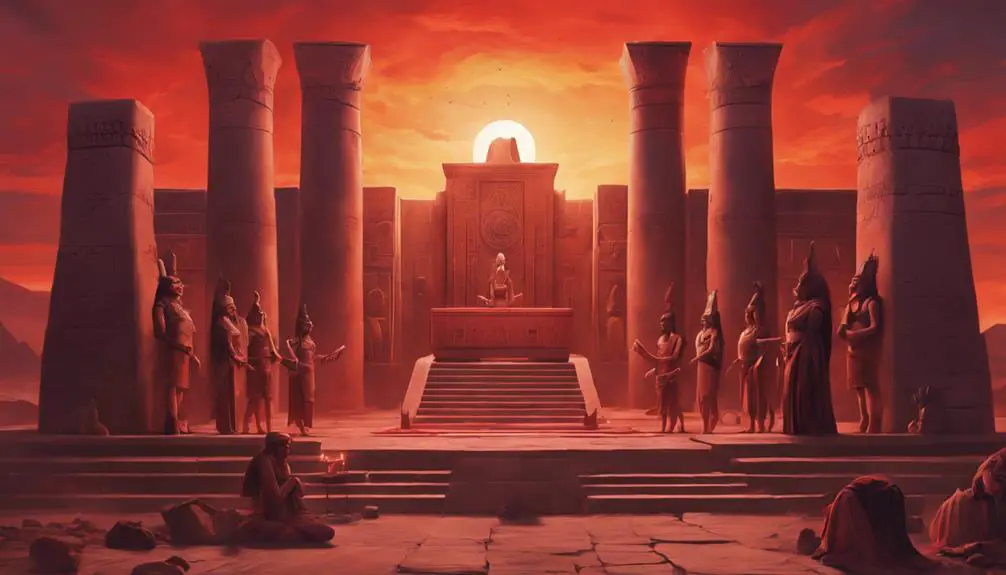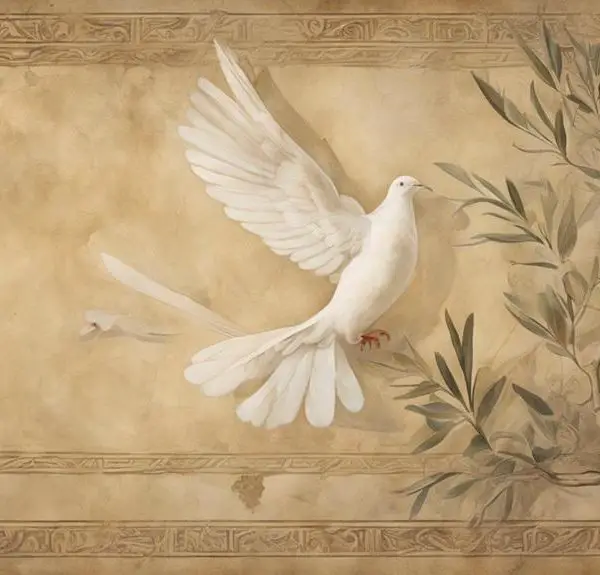Journey into the enigmatic world of Nergal, a deity mentioned in the Bible, to unravel its mysterious influence on ancient narratives.

Nergal in the Bible
Isn't it fascinating how you stumble upon figures in the Bible whose stories seem shrouded in mystery?
Take Nergal, for example. You've probably skimmed through 2 Kings without giving much thought to this deity mentioned in passing. Originating from the city of Cuth, Nergal's brief mention opens a window into the complex world of religious syncretism that influenced the Israelites.
As you explore Nergal's role further, you'll uncover layers of history and belief that challenge the straightforward narrative you might expect, inviting you to question how and why such figures made their way into the biblical text.
Key Takeaways
- Nergal's presence in 2 Kings illustrates Assyrian cultural influence on Hebrew scriptures.
- The worship of Nergal in Cuth highlights the blending of Assyrian and Hebrew traditions.
- Nergal's integration into Israelite beliefs reflects ancient practices of religious syncretism.
- Israelite resistance to Nergal underscored efforts to maintain cultural and theological purity.
Who Was Nergal?

In the biblical context, Nergal emerges as a deity whose origins and significance are deeply enmeshed within the ancient Mesopotamian pantheon, reflecting a complex interplay of cultural and religious influences. As a Mesopotamian deity, he's not just a footnote in the annals of mythology; rather, he embodies the multifaceted nature of divine representation in ancient Near Eastern religions. Delving deeper, you'll find Nergal's astral associations particularly fascinating. He's closely linked with the planet Mars, embodying attributes of destruction, war, and the underworld. This celestial connection isn't mere happenstance—it's a testament to the sophisticated astronomical knowledge and the theological symbolism prevalent among the Mesopotamians.
Analyzing Nergal's role, it's clear that his influence extended beyond mere mythology; he played a pivotal part in reflecting and shaping the socio-religious landscape of his time. His dual nature as both a destroyer and a protector underscores the Mesopotamians' nuanced understanding of the divine, where gods weren't pigeonholed into strictly benevolent or malevolent categories. Instead, Nergal's character invites you to explore the complexity of ancient deities, offering insights into how the Mesopotamians navigated the uncertainties of their world through religion.
Nergal's Mention in 2 Kings

Turning to the biblical narrative, you'll discover that Nergal's presence is notably acknowledged in the Second Book of Kings, where his influence extends into the Hebrew scriptures. This mention not only underlines the Assyrian influence on the regions described in the Bible but also sheds light on the complexities surrounding Biblical accuracy. The reference to Nergal, an Assyrian deity, within a Hebrew text, points towards the intermingling of cultures and religious practices during the periods of Assyrian dominance.
Aspect |
Analysis |
|---|---|
Assyrian Influence |
Demonstrates the Assyrian cultural and religious impact on Israel and Judah. |
Biblical Accuracy |
Challenges and enriches our understanding of the historical context of the scriptures. |
Cultural Intermingling |
Highlights the blending of Assyrian and Hebrew traditions. |
Scholarly Significance |
Offers a critical perspective on the interpretation of ancient texts. |
These elements, when woven together, enhance the scholarly analysis of Nergal's mention in 2 Kings. It's a testament to the layered and nuanced nature of the biblical text, inviting readers to consider the broader geopolitical and cultural dynamics at play during the era. This mention of Nergal, thus, serves as a bridge, linking the historical to the divine, the Assyrian to the Hebrew, and the ancient to the contemporary in the quest for understanding.
The City of Cuth Connection

Building on the mention of Nergal in 2 Kings, it's crucial to explore the city of Cuth's significant role in understanding this Assyrian deity's influence within the Hebrew scriptures. Cuth's origins, deeply entrenched in Mesopotamian history, offer a fascinating glimpse into the cultural and religious dynamics that shaped the ancient Near East. Archaeological findings have been pivotal in unraveling Cuth's historical and religious landscape, providing concrete evidence of Nergal's worship within this city.
You'll find that Cuth wasn't just any city; it was a melting pot of cultural and religious ideologies, predominantly influenced by Assyrian conquests. These findings illuminate the complexities of Nergal's integration into the pantheon of gods worshipped by the people of Cuth. The artifacts unearthed, from inscriptions to temple remnants, speak volumes about the city's religious architecture and the deity's esteemed place within it.
This connection between Nergal and the city of Cuth, substantiated by archaeological evidence, underscores the intricate web of cultural exchange and religious adaptation. It's a testament to the multifaceted character of ancient Near Eastern religion, where deities like Nergal found reverence far from their original Sumerian roots, shaping the spiritual landscape of cities such as Cuth.
Religious Syncretism Explored

Through the lens of religious syncretism, we'll explore how Nergal's worship in Cuth represents a broader trend of deities merging across cultural lines in the ancient Near East. This phenomenon wasn't isolated but a part of the syncretic evolution that shaped the religious landscape of the region. The blending of Nergal's worship with that of other deities and cultures exemplifies the complexity of cultural assimilation and religious adaptation.
Here are four key aspects of this process:
- Cultural Exchange: As peoples interacted through trade, conquest, and migration, their religious beliefs and practices often merged, leading to a rich tapestry of shared deities and rituals.
- Adaptation and Assimilation: Local deities like Nergal were sometimes identified with similar gods from conquering or neighboring cultures, facilitating cultural assimilation.
- Political and Social Influence: Rulers and elites often promoted syncretism to consolidate power and foster unity among diverse populations.
- Evolution of Religious Practice: Over time, these syncretic practices evolved into distinct traditions, illustrating the dynamic nature of religious belief and expression.
The case of Nergal in Cuth highlights the intricate web of religious syncretism and its role in the cultural and spiritual life of the ancient Near East.
The Israelite Perspective

From the Israelite perspective, Nergal's integration into the religious practices at Cuth not only reflects the multifaceted nature of ancient Near Eastern syncretism but also underscores the challenges and complexities of maintaining a distinct religious identity amidst pervasive cultural exchanges. You see, the adoption of Nergal, a deity associated with the underworld and pestilence, into their neighboring cultures' pantheons stirred deep Israelite fears. This was not just about theological purity; it was about cultural survival.
Aspect |
Impact on Israelites |
|---|---|
Theological Purity |
Threatened by syncretism |
Cultural Identity |
Undermined by foreign practices |
Social Stability |
Destabilized by new religious elements |
Political Autonomy |
Compromised by external influences |
Spiritual Well-being |
Endangered by idolatrous practices |
Israelites' reaction to Nergal's presence reveals a profound cultural resistance. This isn't merely a rejection of foreign gods but a fight to preserve a unique identity. Their fears were not unfounded. The blending of religious identities could dilute their distinctiveness, leading to a loss of cultural and spiritual autonomy. The Israelite response, steeped in a desire to maintain purity, becomes a testament to the challenges of preserving one's identity in a constantly interacting world.
Frequently Asked Questions
How Has the Interpretation of Nergal's Role in the Bible Changed Over Time Among Different Theological Scholars?
You've noticed that interpretations of Nergal's role have shifted significantly among theologians over time. Initially, scholarly debates centered on Nergal's symbolism, often linking him to themes of destruction and the underworld.
As scholarship evolved, so did perspectives on his significance, with recent discussions focusing more on his broader cultural and religious implications. This shift reflects a deeper analytical approach, where scholars delve into historical contexts and nuanced interpretations, enriching our understanding of Nergal's place in ancient narratives.
Are There Any Archaeological Findings That Have Contributed to Our Understanding of Nergal's Worship Practices Outside the Biblical Context?
Yes, archaeological excavations have unearthed insights into Nergal's worship practices. Through advanced excavation methodologies, researchers have discovered temples and artifacts linked to his veneration.
These findings, coupled with meticulous artifact preservation techniques, have allowed scholars to piece together a more detailed understanding of how Nergal was worshipped outside the biblical narrative. This evidence provides a richer, more nuanced view of ancient religious practices, emphasizing the complexity of historical worship.
How Does Nergal's Depiction in the Bible Compare to His Portrayal in Other Ancient Near Eastern Texts?
In comparing Nergal's attributes across ancient texts, you'll find his portrayal varies significantly. Unlike the Bible, where details might be sparse, other Near Eastern texts provide richer insights into his character, emphasizing his underworld connections and associations with war and plague.
This comparative mythology approach highlights how cultures adapted Nergal's image to fit their narratives, showcasing a fascinating blend of reverence and fear that transcended individual mythological systems.
What Is the Significance of Nergal in Contemporary Religious or Spiritual Practices, if Any?
You might find Nergal playing a nuanced role in modern spiritual landscapes, though not always directly tied to his ancient origins.
Modern adaptations of Nergal weave him into spiritual symbolism, reflecting themes of transformation, rebirth, or even destruction leading to renewal.
These interpretations are often deeply personal, serving as a bridge between ancient mythologies and contemporary spiritual quests.
Analyzing these connections reveals how ancient deities like Nergal retain relevance in today's spiritual practices.
Can Parallels Be Drawn Between the Story of Nergal in the Bible and Similar Figures in Other Ancient Mythologies or Religious Texts?
Yes, you can certainly find mythological parallels when you delve into comparative mythology. Other ancient mythologies and religious texts feature figures similar to Nergal, showcasing themes of the underworld, death, and conflict.
Conclusion
In conclusion, Nergal's presence in the Bible underscores the complex interplay of religious identities in ancient times. Specifically highlighted in 2 Kings, Nergal represents not just a deity from Cuth but a symbol of religious syncretism.
This blending of beliefs, as seen through the Israelite perspective, illuminates the broader dynamics at play within these ancient societies. It reveals a nuanced understanding of how different cultures and religions interacted, adapted, and influenced one another, shaping the spiritual landscape of the era.



Sign up